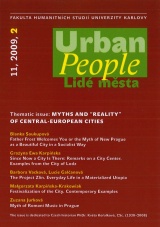Father Frost Welcomes You or the Myth of New Prague as a Beautiful City in a Socialist Way
1948–1953, until the Deaths of Stalin and Gottwald
DOI:
https://doi.org/10.14712/12128112.3655Klíčová slova:
socialist city, Prague, mythAbstrakt
The study applies the proposition of French anthropologist Marc Augé that the city is an exemplary object of the imagination to Prague after the Communist Revolution (1948), when the Communists quickly reinforced their position as the leading political power. In Prague they offered an image of the beautiful socialist city of the future. Specific fulfillment of this myth meant the factual and symbolic occupation of the capital. The Communists won decisive influence in communal politics, nationalized numerous buildings in the city and their inventory, eliminated urban tradesmen. A harsh centralized bureaucracy and service went hand in hand with a transformation of the urban space. A myth could fill only a city with a well-arranged plan, with generous high-rise buildings, with extensive residential buildings, with purpose-built infrastructure, with new historical traditions and with new symbols. The socialist city went the way of balancing social differences with extensive investments in its outskirts. The center of the city, earlier inaccessible to the lower social classes, decayed. The Communist myth of the socialist city was an inseparable part of the Party ideology. In practice, however – and in view of the inefficient economy and investments in preferred parts of the state – in Prague it clashed with daily reality. In its light although it appears homogeneous, at the same time, however, it appears like an empty ideological-political construct.
Stahování
Publikováno
Jak citovat
Číslo
Sekce
Licence

Tato práce je licencována pod Mezinárodní licencí Creative Commons Attribution-NonCommercial-NoDerivatives 4.0.


